Eddy current: A circular water movement that develops when the main flow becomes separated from the bank. The eddy current may then be set up between the main flow and the bank.
Embankment: The part of the soil next to a stream, lake or body of water where the soil elevation adjacent to the water is higher than the water level. Usually referred to as the “bank.”
Failure: Collapse or slippage of a large mass of bank material into a stream.
Fetch: The area in which seas are generated by a wind having a rather constant direction and speed.
Filter: Layer of fabric, sand, gravel, or graded rock placed between the bank revetment or channel lining and soil for one or more of three purposes: to prevent the soil from moving through the revetment; to prevent the revetment from sinking into the soil; and to permit natural seepage from the streambank, thus preventing buildup of excessive groundwater pressure.
Flanking: Stream flow between a structure and the bank, possibly occurring because the structure was not properly tied into the bank. See wingwall.
Foreshore: The part of the shore lying between the crest of the berm (or upper limit of wave wash at high tide) and the ordinary low-water mark that is ordinarily traversed by the uprush and backrush of the waves as the tides rise and fall.
Gabion wall: A wall constructed of baskets (usually made of wire) filled with rock or broken pieces of concrete, used for erosion control.
Greenbelt: A strip of trees and shrubs growing parallel to a stream that prevents overuse of the top bank area by man, animals, and machinery. This strip of vegetation also retards rainfall runoff down the bank slope and provides a root system that binds soil particles together.
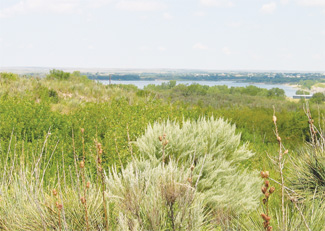
Groin: A shore protection structure built (usually perpendicular to the shoreline) to trap littoral drift or retard erosion of the shore.
Groundwater flow: Water that moves through the subsurface soil and rocks.
Groundwater table: The depth below the surface where the soil is saturated.
Headcutting: The action of an upstream moving waterfall or locally steep channel bottom with rapidly flowing water through an otherwise placid stream. These conditions often indicate that a readjustment of a stream’s discharge and sediment load characteristics is taking place.
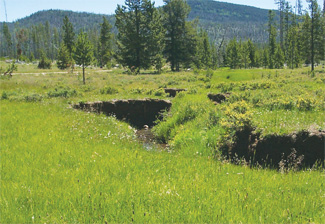
Jetting: A method of placing piles or sheeting by forcing water around and under a pile or sheeting to displace and lubricate the surrounding soil, allowing the pile or sheeting to sink to the desired position.
Launching: Process where stone stockpiled along top bank is undercut and slides down slope thus protecting the bank against future erosion.
Littoral: Pertaining to the tidal zone.
Littoral drift: The sedimentary material moved in the littoral zone under the influence of waves and currents.
Littoral transport: The movement of littoral drift along the shoreline by waves and currents.
Longshore: Parallel to and near the shoreline.
Lower bank: That portion of the streambank below the elevation of the average water level of the stream.
Neap tide: A tide having about 10 or 30 percent less range than the average, occurring about the time of quarter moons.
Nourishment: The process of replenishing a beach. It may be brought about naturally, by accretion due to the longshore transport, or artificially, by the deposition of dredged materials.
Overbank drainage: Water flow over top bank and down the slope.
Overtopping: The passing of water over the top of a natural or man-made structure as a result of wave runup or surge.
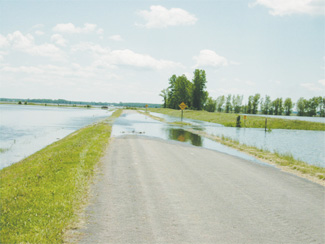
Palisade: A barrier.
Perched Beach: A beach retained above the otherwise normal profile level by a submerged sill.
Pile: A long, heavy timber, pipe, or section of concrete or metal to be driven or jetted into the earth or seabed to serve as a support for a bulkhead.
Pile rot: The rotting of wood pile caused by exposure to the weather.
Piping: Flow of groundwater through subsurface conduits in the bank.
Point bar: The bank in a bend that has built up due to sediment deposition.
Rapid drawdown: Lowering the elevation of water against a bank faster than the bank can drain leaving a pressure imbalance that may cause the bank to fail.
Reach: A section of a stream”s length.
Revetment: A facing of stone, bags, blocks, pavement, etc., used to protect or armor a bank against erosion.
Rill erosion: Removal of soil particles from a bank slope by surface runoff moving through relatively small channels.
Riprap: A layer, facing, or protective mound of stones, randomly placed to prevent erosion or scour at a structure or embankment, also the stone so used.
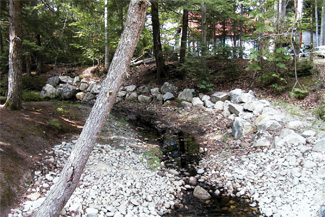
River training works: Structures placed in a stream to direct the current into a predetermined channel.
Rooted: Expression indicating that a bank has been excavated and the end of a structure (check dam, dike, etc.) has been placed in the cavity, thus retarding future stream-flow around the end of the structure (flanking).
Runup: The rush of water up a beach or structure, associated with the breaking of a wave. The amount of runup is measured according to the vertical height above still water level that the rush of water reaches.
Scour: The erosive action of flowing water in streams that removes and carries away material from the bed and banks.
Sediment load: The soil particles transported through a channel by streamflow.
Seepage: Groundwater emerging on the face of a streambank.
Shear: Force parallel to a surface as opposed to directly on the surface. An example of shear would be the tractive force that removes particles from a streambank as flow moves over the surface of the slope; on the other hand, a floating log that directly strikes the bank would not be a shear force.
Sheet erosion: The removal by surface runoff of a fairly uniform layer of soil from a bank slope.
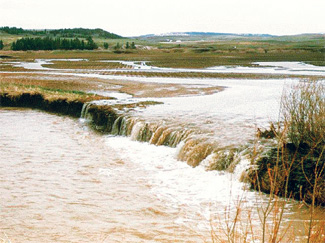
Sheet pile: A pile with a generally slender, flat cross-section that is driven into the ground or bottom of a water body and meshed or interlocked with like members to form a wall or bulkhead.
Sloughing (or sloughing off): Movement of a mass of soil down a bank into the channel (also called slumping). Sloughing is similar to a landslide.
Spring tide: A tide that rises highest and falls lowest from mean sea level, occurring at new or full moon.
Streambank protection works: Structure(s) placed on or near a distressed streambank to control bank erosion or to prevent failure.
Tie-back: A variety of techniques used to secure the bulkhead, seawall or revetment in place against the bank.
Tied in: An expression used to indicate that a revetment or dike is constructed to prevent or minimize streamflow between the structure and the bank. See wingwall.
Toe: The break in slope at the foot of a bank where the bank meets the bed.
Tractive force: The drag of passing water that pulls soil particles along with the streamflow.
Updrift: The longshore direction opposite that of the predominant movement of littoral materials.
Unravel: To lose material from the edges of a revetment.
Updrift: The direction opposite that of the predominant movement of littoral materials.
Wale: Structural element of a bulkhead fixed horizontally between the vertical piles on the seaward side and the sheet piles on the landward side.
Watershed: An area confined by drainage divides usually having only one streamflow outlet. Also known as a drainage divide or catchment.
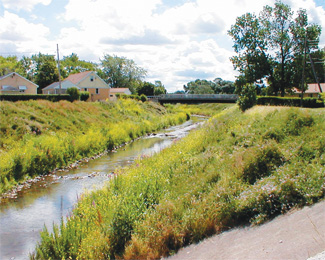
Wave attack: Impact of waves on a streambank.
Wave length: The horizontal distance between similar points on two successive waves (for example, crest to crest or trough to trough) measured in the direction of wave travel.
Wave height: The vertical distance between a wave crest and the preceding trough.
Weephole: Opening in a revetment or bulkhead to allow groundwater drainage.
Wingwall: The end portion of a bulkhead, seawall, or revetment that cuts back in toward the bank, usually at a right angle to the main structure. The purpose of a wingwall is to help retard or prevent flanking.
